Geokon 4600 User manual

Instruction Manual
Model 4600
VW Settlement Sensor
No part of this instruction manual may be reproduced, by any means, without the written consent of Geokon, Inc.
The information contained herein is believed to be accurate and reliable. However, Geokon, Inc. assumes no responsibility for
errors, omissions or misinterpretation. The information herein is subject to change without notification.
Copyright © 1984, 2004, 2009, 2011, 2013, 2015 by Geokon, Inc.
(Doc Rev J, 10/15)


Warranty Statement
Geokon, Inc. warrants its products to be free of defects in materials and workmanship, under normal use and
service for a period of 13 months from date of purchase. If the unit should malfunction, it must be returned to the
factory for evaluation, freight prepaid. Upon examination by Geokon, if the unit is found to be defective, it will be
repaired or replaced at no charge. However, the WARRANTY is VOID if the unit shows evidence of having been
tampered with or shows evidence of being damaged as a result of excessive corrosion or current, heat, moisture or
vibration, improper specification, misapplication, misuse or other operating conditions outside of Geokon's
control. Components which wear or which are damaged by misuse are not warranted. This includes fuses and
batteries.
Geokon manufactures scientific instruments whose misuse is potentially dangerous. The instruments are intended
to be installed and used only by qualified personnel. There are no warranties except as stated herein. There are no
other warranties, expressed or implied, including but not limited to the implied warranties of merchantability and
of fitness for a particular purpose. Geokon, Inc. is not responsible for any damages or losses caused to other
equipment, whether direct, indirect, incidental, special or consequential which the purchaser may experience as a
result of the installation or use of the product. The buyer's sole remedy for any breach of this agreement by
Geokon, Inc. or any breach of any warranty by Geokon, Inc. shall not exceed the purchase price paid by the
purchaser to Geokon, Inc. for the unit or units, or equipment directly affected by such breach. Under no
circumstances will Geokon reimburse the claimant for loss incurred in removing and/or reinstalling equipment.
Every precaution for accuracy has been taken in the preparation of manuals and/or software, however,
Geokon, Inc. neither assumes responsibility for any omissions or errors that may appear nor assumes
liability for any damages or losses that result from the use of the products in accordance with the
information contained in the manual or software.

TABLE of CONTENTS
1. GENERAL DESCRIPTION .............................................................................................................................. 1
2. INSTALLATION PROCEDURES.................................................................................................................... 3
3. TAKING READINGS ........................................................................................................................................ 4
3.1. Measuring Temperatures.................................................................................................................................... 5
4. DATA REDUCTION.......................................................................................................................................... 5
4.1 Corrections for temperature.................................................................................................................................. 6
5. MAINTENANCE AND TROUBLE SHOOTING ........................................................................................... 8
APPENDIX A: THERMISTOR LINEARIZATION USING STEINHART AND HART LOG EQUATION
.................................................................................................................................................................................. 9
APPENDIX B: MODEL 4600M MULTILEVEL SETTLEMENT MONITORING SYSTEM GENERAL
DESCRIPTION......................................................................................................................................................10
Installation Instructions. ............................................................................................................................................. 13
APPENDIX C: SPECIFICATIONS.....................................................................................................................15

1
1. GENERAL DESCRIPTION
The 4600 Settlement System is designed to measure the settlement of a point relative to a
point located immediately below it, in solid ground (bedrock). The usual method of installation
is shown in Figure 1.
The 4600 system has the disadvantage of requiring a borehole to reach solid ground but has
the distinct advantage of avoiding the necessity for long horizontal runs of liquid-filled tubing to
a remote readout location. The system is particularly suited to the measurement of
settlements below sand islands constructed in marine environments.
A series of 4600 system, installed vertically above each other in a single borehole, can be
used to monitor subsurface settlements at different elevations.
A pressure sensor is located in solid ground by attaching it to the upper end of a steel pipe, or
rod, placed inside a borehole drilled to bedrock. The lower end of the pipe is grouted in place.
A liquid-filled tube extends upwards from the sensor to the reservoir, which is attached to a
settlement plate.
Figure 1. Model 4600 V.W. Settlement System.

2
The settlement plate, usually located at the ground surface, (i.e. the elevation of the mouth of
the borehole) settles with the ground, thus altering the height of the liquid column inside the
liquid tube above the sensor. The sensor detects the change in liquid pressure and is read by
means of an electrical cable running up the borehole and then horizontally to the readout
location.
Standard systems are filled with either de-aired water or de-aired antifreeze solution, with
chemicals added to prevent the growth of algae. The system is “closed” in that the inside of
the sensor is connected, via a vent line,
to the space above the reservoir. A desiccant chamber prevents moisture from entering the
vent line from
the reservoir.
This arrangement ensures that the sensor readings are not influenced by temperature
changes inside the reservoir, or by changes in barometric pressure. Details of the reservoir
assembly are shown in Figure 2.
Figure 2. Model 4600 Settlement System –Reservoir Details

3
Readout is accomplished by GK-403, G- 404,or GK-405 Readout Boxes or by a Datalogger.
The sensor contains a thermistor for the measurement of temperatures and also gas-
discharge tubes for lighting protection.
2. INSTALLATION PROCEDURES
Installation generally requires a borehole to be drilled. The required borehole diameter is
75mm (3”) or larger.
Any casing, if used, should have an inner diameter greater than 70mm (2 ½”). The
recommended distance between the sensor and the reservoir for the standard sensor range
(7 meters) is 3 to 5 meters. The minimum spacing can be smaller so long as the spacing
exceeds 3 times the anticipated maximum settlement. Thus if the anticipated maximum
settlement is 0.5 meters, the sensor/reservoir spacing can be as close as 1.5 meters.
The Model 4600 Assembly is usually shipped with the liquid tube pre-filled with de-aired liquid.
The liquid tube
is of such a length to accommodate the spacing between sensor and reservoir specified at the
time of ordering. Measure the depth of the borehole and prepare a length of pipe, (1” water-
pipe is ideal), which will place the sensor at the desired elevation, (usually from 3 to 5 meters
below the surface depending on the anticipated settlement, as previously discussed.)
Attach the sensor to the upper end of the pipe (the sensor normally has a matching thread
built into it). Tie a long piece of rope to the upper end of the pipe and lightly tape a grout pipe
to the lower end of the pipe. Lower the pipe into the borehole until it rests on the bottom.
Tremie full strength grout into the bottom 1.5 meters of the borehole. Pull the grout-pipe up 2
meters and tremie in a soft bentonite grout until the borehole is full.
If the hole is cased, the casing can now be removed. But first, tie the reservoir and signal
cable to the rope and tie the rope to the top of the drill mast so that the casing can slide over
and around the reservoir and signal cable as the casing is removed from the borehole.
4600 Settlement Systems are usually shipped with the reservoir completely filled with de-aired
liquid so that there is no danger of air bubbles entering the liquid tube during shipment. But,
because there is a danger that temperature changes during shipment could cause pressure
changes sufficient to push the reservoir plug out of its housing and spill fluid, there is a small
diameter ’travelling tube’ connected to the reservoir plug. This ‘travelling tube’ is half-filled
with water and connects to the water in the reservoir keeping the pressure inside the reservoir

4
at the ambient atmospheric pressure during shipment no matter what the temperature.
To put the 4600 system into service it is necessary, first, to grip the Swagelok cap holding the
travelling tube and pull the reservoir plug out of the top of the reservoir, (the larger of the two
Delrin plugs). Suck 10cc of liquid from the top of the reservoir using the syringe provided. (The
syringes provided have a capacity of 12cc). Add a few drops of light oil to the surface of the
liquid to prevent evaporation. Push the reservoir plug back into place and remove the cap
holding the travelling tube. Remove the other Swagelok cap and connect the short copper U-
tube supplied, with fittings, to the top of the reservoir and the top of the desiccant chamber.
Attach the settlement flange to the settlement plate using the bolts supplied.
While holding the reservoir in an upright position at all times, the settlement flange and plate
can now be attached to the reservoir using the two machine screws provided or by using PVC
cement obtained locally. (Federal Regulations prohibit the shipment of PVC cement). Apply
PVC cement to the inside of the reservoir extension (see Figure 2) and to the outside of the
top of the reservoir housing. Be careful at all times not to allow the reservoir to tip over on its
side which would allow liquid to enter the vent line.
Position the settlement flange at the top of the borehole and dig a trench leading from the
borehole to the readout location into which the signal cable can be buried. Avoid sharp bends
where the cable exits the borehole by excavating a broad sweep from the borehole to the
trench (see Figure 1).
Bury the signal cable in the trench using sand or other fine grain materials around the cable to
protect the cable from damage.
Terminate the signal cable inside a readout enclosure mounted on a post or pipe driven into
the ground at the readout location.
3. TAKING READINGS
Take the initial reading, R0, several times to ensure a good baseline reading. Read the
temperature also. An insitu calibration check, of sorts, can be made by raising the reservoir
flange by a measured amount and observing the change in readout thus produced. Compare
this calibration with the factory calibration. Alternatively, the initial gage reading, when
converted to a height of liquid column, should correspond with the known difference in
elevation between the reservoir and sensor.
Readings should be taken by a Model GK-403, GK-404 or GK-405 Readout Box set to display

5
position B. Where a Datalogger is used the frequency limits should be set between 1400 to
3500 Hz.
The black and red conductors are connected to the vibrating wire sensor and the green and
white conductors to
the thermistor.
When taking initial readings conduct a level survey to determine the elevation, E0, of the
settlement flange.
3.1. Measuring Temperatures
Each vibrating wire settlement sensor is equipped with a thermistor for reading temperature.
The thermistor gives a varying resistance output as the temperature changes. Usually the
white and green leads are connected to the internal thermistor. Temperatures can also be
read using an ohmmeter.
1. Connect the ohmmeter to the two thermistor leads coming from the transducer. (Since the
resistance changes with temperature are so large, the effect of cable resistance is usually
insignificant.)
2. Look up the temperature for the measured resistance in Appendix A. Alternately the
temperature could be calculated using the Equation in appendix A.
Note: The GK-403, GK-404 and GK-405 readout boxes will read the thermistor and display
temperature in
C automatically.
4. DATA REDUCTION
The elevation, E, of the settlement flange at subsequent measurement times is given by the
equation.
E = E0+ (R1–R0) G
where R0is the initial reading on channel B,
R1is the subsequent reading on channel B,
and Gis the calibration factor supplied with the sensor.

6
A typical calibration sheet, as supplied by the factory, is shown in Figure 3 (page 6).
E0= 541.62 meters
R0= 7510
R1= 7782
G= -0.001712 m/digit
E= 541.62 + (7782 –7510) (-0.001712) meters
E= 541.15 meters
Or, in other words, there has been a settlement of 0.47 meters.
4.1 Corrections for temperature
Usually, since the 4600 system is completely buried, temperature effects are negligible.
The temperature correction to the elevation, ET,is given by:
ET= E0+ (R1–R0) G + (T1–T0) K
Where K is the Thermal factor given on the calibration sheet.
Please note that the calibration sheet shown in figure 3 was developed using a simple
manometer and is good only over a range of 3 meters height differential between reservoir
and sensor. If this range is exceeded by the initial set-up or by large amounts of settlement
then there are two options: a), continue to use the calibration sheet shown in figure 2 or, b)
use the second calibration sheet, supplied with the equipment, which was developed by
calibrating the pressure sensor itself over a wider range.

7
Figure 3. Typical Calibration Sheet

8
5. MAINTENANCE AND TROUBLE SHOOTING
Since all the 4600 Settlement System components are buried there is no maintenance to
observe and little can be done in the event the readings become suspect. Unstable readings,
especially with data loggers, may be caused by electrical noise from nearby power lines or
electrical equipment. Make sure that the ground conductor is connected to the ground on the
datalogger, or to the blue clip on the GK403, GK404 or GK405 patchcord.
Resistance between the black and red conductors should be 180 ohms 10 ohms plus 5
ohms for every 100 meters of lead wire.
Resistance between the green and white wires depends on the temperature as shown by the
Thermistor Chart in Appendix A (page 9).

9
Appendix A: Thermistor Linearization using Steinhart and Hart Log Equation
Tech Memo 91-03 Doc Rev 6-94, Geokon, Inc.
Thermistor Type: YSI 44005, Dale #1C3001-B3, Alpha #13A3001-B3
Basic Equation:
TA B LnR C LnR
1273 2
3
( ) ( ) .
where: T
Temperature in
C.
LnR
Natural Log of Thermistor Resistance
A
1.4051
10-3
B
2.369
10-4
C
1.019
10-7
Note: Coefficients calculated over -50
to +150
C. span.
Resistance versus Temperature Table
Ohms
Temp
Ohms
Temp
Ohms
Temp
Ohms
Temp
Ohms
Temp
201.1K
-50
16.60K
-10
2417
30
525.4
70
153.2
110
187.3K
-49
15.72K
-9
2317
31
507.8
71
149.0
111
174.5K
-48
14.90K
-8
2221
32
490.9
72
145.0
112
162.7K
-47
14.12K
-7
2130
33
474.7
73
141.1
113
151.7K
-46
13.39K
-6
2042
34
459.0
74
137.2
114
141.6K
-45
12.70K
-5
1959
35
444.0
75
133.6
115
132.2K
-44
12.05K
-4
1880
36
429.5
76
130.0
116
123.5K
-43
11.44K
-3
1805
37
415.6
77
126.5
117
115.4K
-42
10.86K
-2
1733
38
402.2
78
123.2
118
107.9K
-41
10.31K
-1
1664
39
389.3
79
119.9
119
101.0K
-40
9796
0
1598
40
376.9
80
116.8
120
94.48K
-39
9310
1
1535
41
364.9
81
113.8
121
88.46K
-38
8851
2
1475
42
353.4
82
110.8
122
82.87K
-37
8417
3
1418
43
342.2
83
107.9
123
77.66K
-36
8006
4
1363
44
331.5
84
105.2
124
72.81K
-35
7618
5
1310
45
321.2
85
102.5
125
68.30K
-34
7252
6
1260
46
311.3
86
99.9
126
64.09K
-33
6905
7
1212
47
301.7
87
97.3
127
60.17K
-32
6576
8
1167
48
292.4
88
94.9
128
56.51K
-31
6265
9
1123
49
283.5
89
92.5
129
53.10K
-30
5971
10
1081
50
274.9
90
90.2
130
49.91K
-29
5692
11
1040
51
266.6
91
87.9
131
46.94K
-28
5427
12
1002
52
258.6
92
85.7
132
44.16K
-27
5177
13
965.0
53
250.9
93
83.6
133
41.56K
-26
4939
14
929.6
54
243.4
94
81.6
134
39.13K
-25
4714
15
895.8
55
236.2
95
79.6
135
36.86K
-24
4500
16
863.3
56
229.3
96
77.6
136
34.73K
-23
4297
17
832.2
57
222.6
97
75.8
137
32.74K
-22
4105
18
802.3
58
216.1
98
73.9
138
30.87K
-21
3922
19
773.7
59
209.8
99
72.2
139
29.13K
-20
3748
20
746.3
60
203.8
100
70.4
140
27.49K
-19
3583
21
719.9
61
197.9
101
68.8
141
25.95K
-18
3426
22
694.7
62
192.2
102
67.1
142
24.51K
-17
3277
23
670.4
63
186.8
103
65.5
143
23.16K
-16
3135
24
647.1
64
181.5
104
64.0
144
21.89K
-15
3000
25
624.7
65
176.4
105
62.5
145
20.70K
-14
2872
26
603.3
66
171.4
106
61.1
146
19.58K
-13
2750
27
582.6
67
166.7
107
59.6
147
18.52K
-12
2633
28
562.8
68
162.0
108
58.3
148
17.53K
-11
2523
29
543.7
69
157.6
109
56.8
149
55.6
150

10
Appendix B: Model 4600M Multilevel Settlement Monitoring System General
Description
The Model 4600M multilevel is designed for installation in boreholes: it is not recommended
for installation in fills while the fill is being placed.
A drawing of the complete assembly is shown in figure 4.
Figure 4 A Typical 4600M assembly
It comprises a series of spring loaded anchors, each anchor containing, at the top, a sensor
and at the bottom a reservoir. This is shown in Figure 5

11
Figure 5 Typical Anchor Assembly

12
Each reservoir is connected via a fluid filled tube to the sensor on the anchor below. The
lowest sensor is mounted to a pipe embedded in the bedrock and the upper reservoir is
connected to a settlement plate at the top of the bore hole.
A more detailed drawing of the top reservoir and settlement plate is shown below in Figure 6.
Figure 6. Details of the Top Multilevel Type Reservoir Assembly and Settlement Plate

13
The bottom sensor is usually anchored in solid ground and serves as a stable datum point to
which all the other sensors are referred. This bottom sensor may be attached to a length of
pipe and grouted in place, as described in Section 2.2 to 2.4, or it may be anchored to the
walls of the borehole by means of a Model 1250-15 Hydraulic Bladder type borehole anchor.
The remaining intermediate sensor / reservoir combinations are anchored in the borehole by
means of spring-loaded anchors which can be hydraulically or manually released when the
sensor / reservoir is at its desired location.
The string of sensor/reservoir combinations is assembled section by section, as the assembly
is lowered into the 5 inch or 6 inch diameter borehole.
Settlement Systems are usually shipped with the reservoir completely filled with de-aired liquid
so that there is no danger of air bubbles entering the liquid tube during shipment. To put the
4600 system into service it is necessary to connect the reservoir chamber to the desiccant
chamber using the U-tube supplied, (see Figure 6). This operation must be performed as each
reservoir is about to be lowered into the borehole.
Installation Instructions.
Begin by connecting the lower sensor to the bottom anchor using the threaded coupling. Any
tremie pipe may now be taped lightly to the lowermost sensor, or to the pipe on which it sits.
Lower the bottom sensor and anchor into the borehole until the first reservoir is in hand,
Remove the Swagelok cap from the top of the reservoir and, using the syringe supplied,
remove about 10cc of fluid. Tilt the Housing slightly and add a few drops of light oil to the
liquid surface to prevent evaporation. Remove the Swagelok cap from the top off the
desiccant chamber and attach the U tube to connect the desiccant chamber to the reservoir.
Now attach the reservoir to the underside of the spring anchor and hold in place using the flat-
head screws provided.
Now attach the next sensor to the spring anchor body using the three cap screws in the spring
anchor body. Tape the cable from the bottom sensor to the body of the spring anchor in a
position that it will not interfere with the free action of the spring as it is tripped.
The spring-loaded anchors are tied and held in their closed position by means of chains and
they are tripped using the pull-pins and trip cords supplied. Attach the bottom trip cord to the
pull pin

14
Repeat the above until all the sensor and reservoirs have been lowered into the borehole and
the top reservoir is at or close to ground level.
As the assembly is lowered into the borehole, more than one person will be required to
organize and control the various trip cords and cables as they are lowered into the
borehole. If pull-cords are used make sure that they are kept free at all times so that the
anchors cannot be tripped prematurely.
When all the sensors and reservoirs have been lowered into the hole the casing can be
pulled, (if the borehole is cased,) taking care not to damage or pull on the electrical cables
coming from each sensor. As the casing is pulled, each spring-loaded anchor can be tripped
as it clears the bottom of the casing. The borehole may be left open, or it may be filled with a
soft bentonite cement grout tremied into the borehole as the tremie pipe is retracted.
Now connect the top reservoir to the underside of the top plate using the machine screws
provided. Pack quick setting cement between the top plate and the ground surface.

15
Appendix C: Specifications
Model
4500AL1
Available Ranges2(ft)
Available Ranges2(m)
0-10, 0-20, 0-50
3, 7, 15,
Resolution
0.025% FS
Linearity
0.5% FS3
Accuracy1
0.1% FS4
Over-Range
2 FS
Thermal
Coefficient
<0.05% FS/
°C
Frequency Range
1400-3500Hz
Vibrating Wire Transducer Specifications
Notes:
1Accuracy of test apparatus: 0.05%
2Other ranges available upon request.
30.1% FS linearity available upon request.
4Derived using 2nd order polynomial.
Other manuals for 4600
1
Table of contents
Other Geokon Accessories manuals
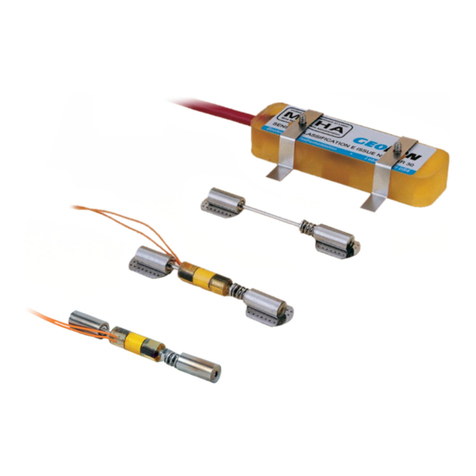
Geokon
Geokon 4100 Series User manual
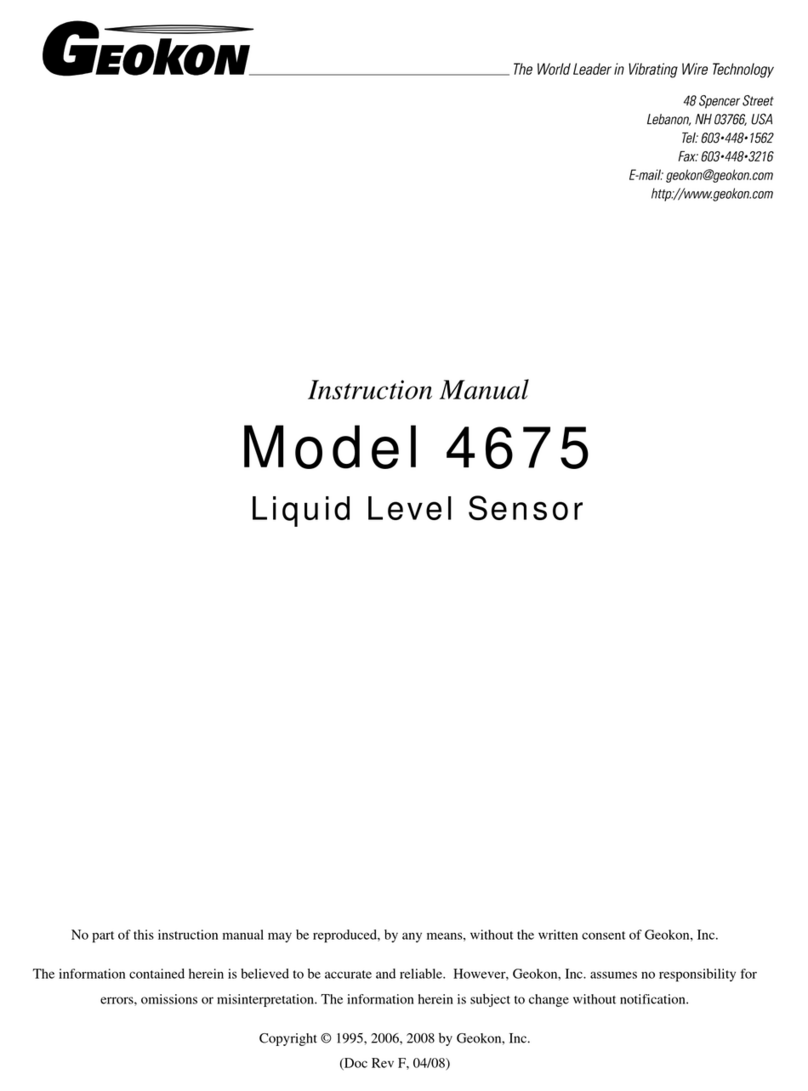
Geokon
Geokon LVRA1230B User manual
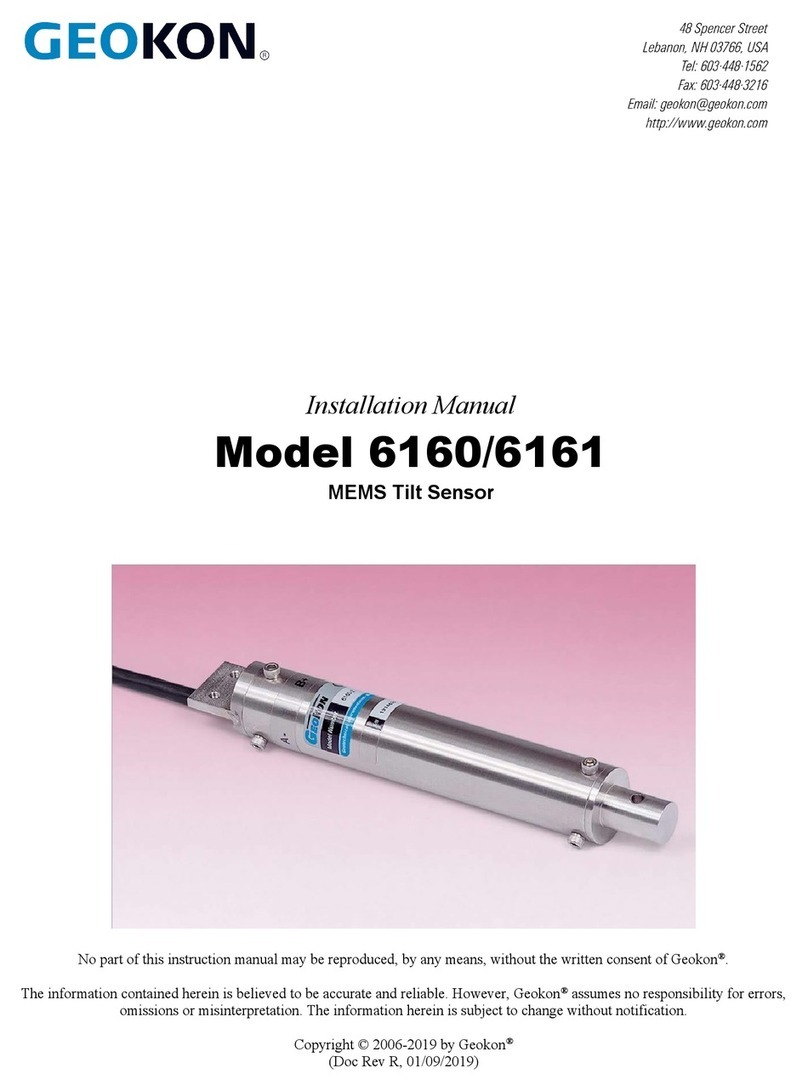
Geokon
Geokon 6160 User manual
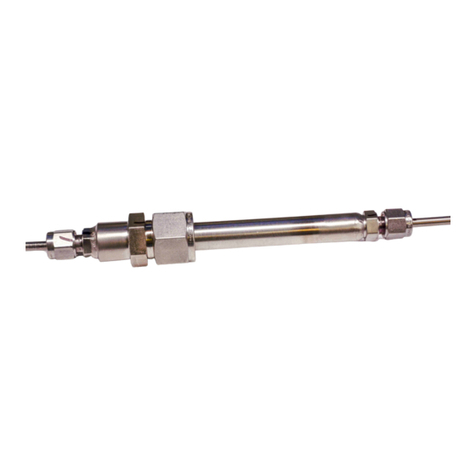
Geokon
Geokon 4500HT-9-5 Manual

Geokon
Geokon 6160 User manual
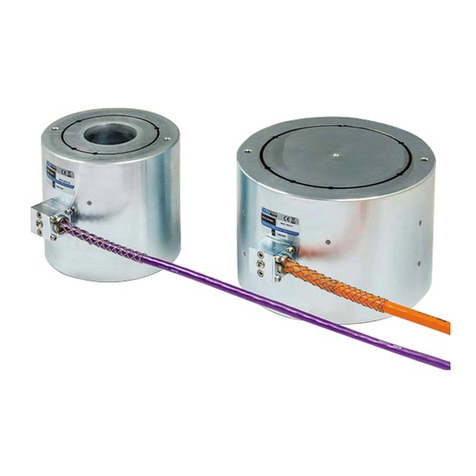
Geokon
Geokon 4900 User manual

Geokon
Geokon RB-500 User manual
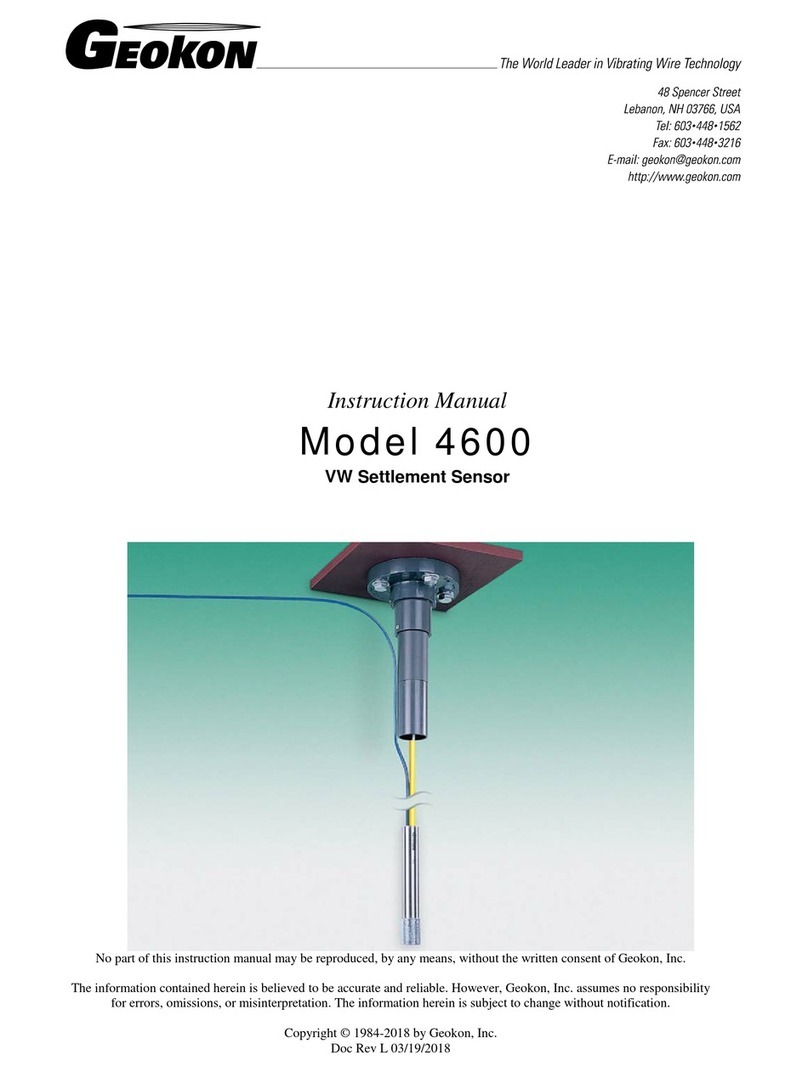
Geokon
Geokon 4600 User manual
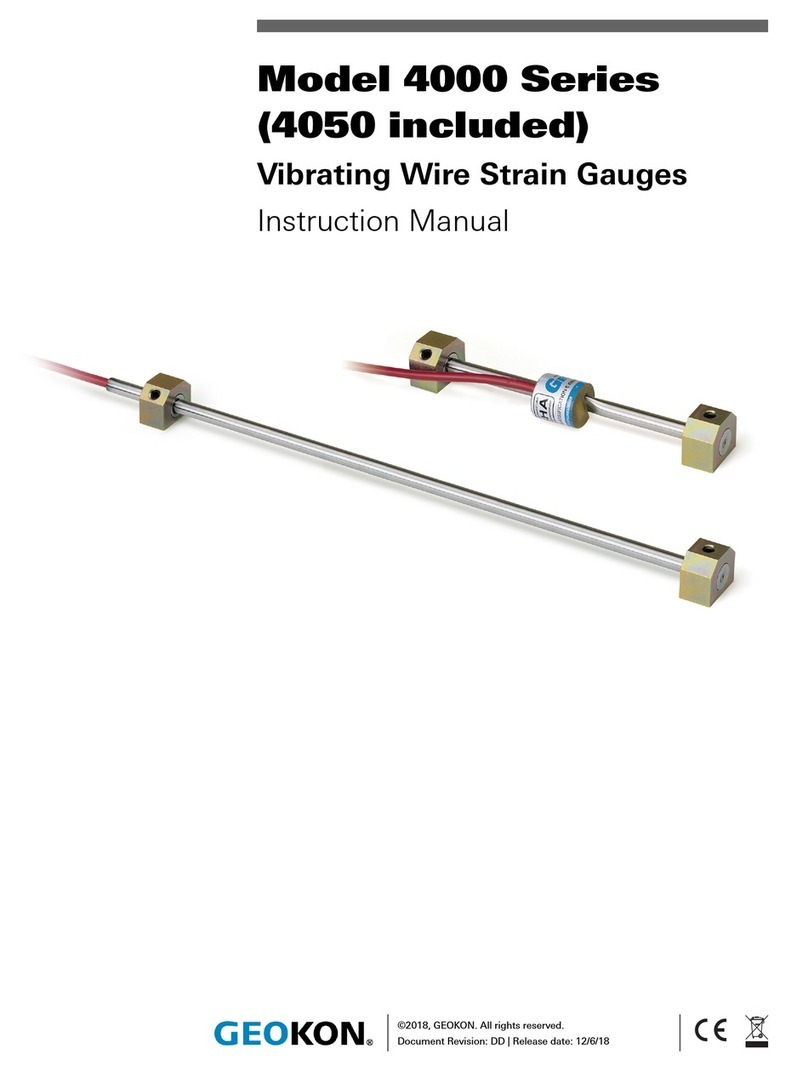
Geokon
Geokon 4000 Series User manual

Geokon
Geokon 6160 User manual

















